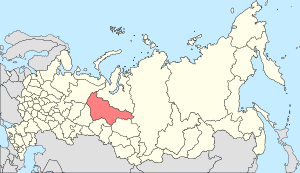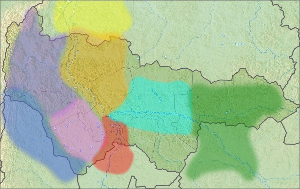
A | B | C | D | E | F | G | H | CH | I | J | K | L | M | N | O | P | Q | R | S | T | U | V | W | X | Y | Z | 0 | 1 | 2 | 3 | 4 | 5 | 6 | 7 | 8 | 9
It has been suggested that this article should be split into articles titled Northern Khanty language, Eastern Khanty language and Southern Khanty language. (discuss) (April 2024) |
| Khanty | |
|---|---|
| ханты ясаң hantĭ jasaŋ | |
| Native to | Russia |
| Region | Khanty–Mansi |
| Ethnicity | 31,467 Khanty people (2020 census)[1] |
Native speakers | 14,000 (2020 census)[1] |
| Dialects |
|
| Language codes | |
| ISO 639-3 | kca |
| Glottolog | khan1279 |
 | |
Khanty (also spelled Khanti or Hanti), previously known as Ostyak (/ˈɒstiæk/),[4] is a Uralic language spoken in the Khanty-Mansi and Yamalo-Nenets Okrugs. There were thought to be around 7,500 speakers of Northern Khanty and 2,000 speakers of Eastern Khanty in 2010, with Southern Khanty being extinct since the early 20th century,[5] however the total amount of speakers in the most recent census was around 13,900.[6][1]
The Khanty language has many dialects. The western group includes the Obdorian, Ob, and Irtysh dialects. The eastern group includes the Surgut and Vakh-Vasyugan dialects, which, in turn, are subdivided into thirteen other dialects. All these dialects differ significantly from each other by phonetic, morphological, and lexical features to the extent that the three main "dialects" (northern, southern and eastern) are mutually unintelligible.[7] Thus, based on their significant multifactorial differences, Eastern, Northern and Southern Khanty could be considered separate but closely related languages.
Alphabet
| А а | Ӑ ӑ | В в | И и | Й й | К к | Л л | Ԓ ԓ (Ԯ ԯ) |
| Љ љ | М м | Н н | Њ њ | Ӈ ӈ (Ң ң) | О о | Ө ө | П п |
| Р р | С с | Т т | ( |
У у | Ў ў | Х х | Ш ш |
| Щ щ | Ь ь | Ы ы | Э э | Ә ә |
Palatalised consonants are designated by either ь or a yotated character.[9]
| Cyrillic | а | ӑ | в | и | й | к | л | љ | ԓ | м | н | њ | ӈ | о | ө | п | р | с | т | у | ў | х | ш | щ | ы | є | э | ә | |
|---|---|---|---|---|---|---|---|---|---|---|---|---|---|---|---|---|---|---|---|---|---|---|---|---|---|---|---|---|---|
| IPA | ɑ | ɐ | β | i | j | k | l | ɬʲ | ɬ | m | n | nʲ | ŋ | ɔ | ɵ | p | r | s | t | tʲ | u | ʉ | x | ʃ | sʲ | ɨ | ɛ | e | ə |
Literary language

The Khanty written language was first created after the October Revolution on the basis of the Latin script in 1930 and then with the Cyrillic alphabet (with the additional letter ⟨ң⟩ for /ŋ/) from 1937.
Khanty literary works are usually written in three Northern dialects, Kazym, Shuryshkar, and Middle Ob. Newspaper reporting and broadcasting are usually done in the Kazym dialect.
Varieties

Khanty is divided in three main dialect groups, which are to a large degree mutually unintelligible, and therefore best considered three languages: Northern, Southern and Eastern. Individual dialects are named after the rivers they are or were spoken on. Southern Khanty is probably extinct by now.[12][13]
Eastern Khanty[14]14">edit
You can help expand this section with text translated from the corresponding article in Russian. Click show for important translation instructions.
|
Transitionaledit
The Salym dialect can be classified as transitional between Eastern and Southern (Honti:1998 suggests closer affinity with Eastern, Abondolo:1998 in the same work with Southern). The Atlym and Nizyam dialects also show some Southern features.
Northern Khantyedit
You can help expand this section with text translated from the corresponding article in Russian. Click show for important translation instructions.
|
Transitionaledit
- Atlym, Nizyam
Southern Khantyedit
You can help expand this section with text translated from the corresponding article in Russian. Click show for important translation instructions.
|
Southern and Northern Khanty share various innovations and can be grouped together as Western Khanty. These include loss of full front rounded vowels: *üü, *öö, *ɔ̈ɔ̈ > *ii, *ee, *ää (but *ɔ̈ɔ̈ > *oo adjacent to *k, *ŋ),[15] loss of vowel harmony, fricativization of *k to /x/ adjacent to back vowels,[12] and the loss of the *ɣ phoneme.[16]
Phonologyedit
A general feature of all Khanty varieties is that while long vowels are not distinguished, a contrast between plain vowels (e.g. /o/) vs. reduced or extra-short vowels (e.g. /ŏ/) is found. This corresponds to an actual length distinction in Khanty's close relative Mansi. According to scholars who posit a common Ob-Ugric ancestry for the two, this was also the original Proto-Ob-Ugric situation.
Palatalization of consonants is phonemic in Khanty, as in most other Uralic languages. Retroflex consonants are also found in most varieties of Khanty.
Khanty word stress is usually on the initial syllable.[17]
Proto-Khantyedit
| Bilabial | Dental | Palatal(ized) | Retroflex | Velar | ||
|---|---|---|---|---|---|---|
| Nasal | *m m |
*n n |
*ń nʲ |
*ṇ ɳ |
*ŋ ŋ | |
| Stop/ Affricate |
*p p |
*t t |
*ć tsʲ |
*č̣ ʈʂ |
*k k | |
| Fricative | central | *s s |
*γ ɣ | |||
| lateral | *ᴧ ɬ |
|||||
| Lateral | *l l |
*ľ lʲ |
*ḷ ɭ |
|||
| Trill | *r r |
|||||
| Semivowel | *w w |
*j j |
||||
19 consonants are reconstructed for Proto-Khanty, listed with the traditional UPA transcription shown above and an IPA transcription shown below.
A major consonant isogloss among the Khanty varieties is the reflexation of the lateral consonants, *ɬ (from Proto-Uralic *s and *š) and *l (from Proto-Uralic *l and *ð).[16] These generally merge, however with varying results: /l/ in the Obdorsk and Far Eastern dialects, /ɬ/ in the Kazym and Surgut dialects, and /t/ elsewhere. The Vasjugan dialect still retains the distinction word-initially, having instead shifted *ɬ > /j/ in this position. Similarly, the palatalized lateral *ľ developed to /lʲ/ in Far Eastern and Obdorsk, /ɬʲ/ in Kazym and Surgut, and /tʲ/ elsewhere. The retroflex lateral *ḷ remains in Far Eastern, but in /t/-dialects develops into a new plain /l/.
Other dialect isoglosses include the development of original *ć to a palatalized stop /tʲ/ in Eastern and Southern Khanty, but to a palatalized sibilant /sʲ ~ ɕ/ in Northern, and the development of original *č similarly to a sibilant /ʂ/ (= UPA: š) in Northern Khanty, partly also in Southern Khanty.
Eastern Khantyedit
Far Easternedit
The Vakh dialect is divergent. It has rigid vowel harmony and a tripartite (ergative–accusative) case system: The subject of a transitive verb takes the instrumental case suffix -nə-, while the object takes the accusative case suffix. The subject of an intransitive verb, however, is not marked for case and might be said to be absolutive. The transitive verb agrees with the subject, as in nominative–accusative systems.
Vakh has the richest vowel inventory, with five reduced vowels /ĕ ø̆ ə̆ ɑ̆ ŏ/ and full /i y ɯ u e ø o æ ɑ/. Some researchers also report /œ ɔ/.[18][19]
